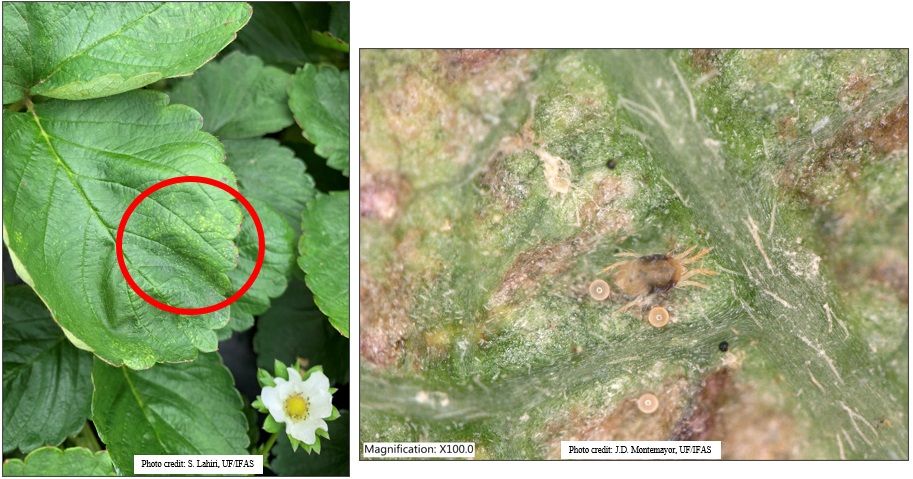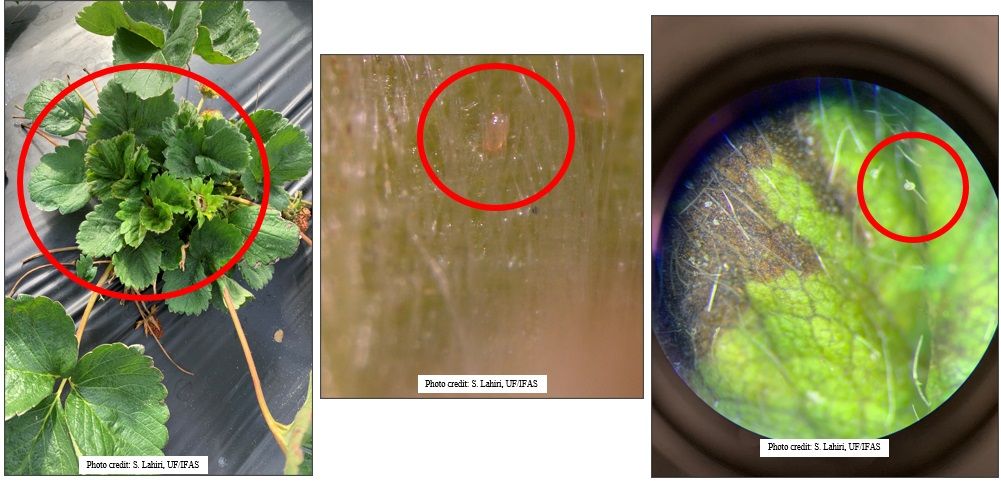The intended audience of this publication is growers, Extension agents, industry partners, and the general public who have an interest in the current availability and adoption of integrated pest management (IPM) tools used by all growers in general and strawberry growers in particular. The purpose of this publication is to establish a baseline of IPM practices adopted by the strawberry industry in Florida so that changes in behavior can be tracked in future.
Introduction
Due to several invasive and native insect and mite pests affecting the strawberry industry, strawberry growers have begun exploring different methods of pest management in addition to chemical control using pesticides. The fresh market strawberry industry in Florida has a production value of $307 million, which is 12% of the national production value (USDA-NASS 2019). Pests affecting this industry include chilli thrips, Scirtothrips dorsalis Hood and western flower thrips, Frankliniella occidentalis (Pergande) (Thysanoptera: Thripidae) (Figure 1); twospotted spider mite, Tetranychus urticae Koch (Figure 2); and cyclamen mite, Phytonemus pallidus (Banks) (Arachnida: Tetranychidae) (Figure 3) (Price et al. 2006; Pinent et al. 2011; Mossler 2013; Cluever et al. 2016; Lahiri and Panthi 2020; Panthi et al. 2021). Damage to fruits appear as bronzing and cracking (Kaur and Lahiri 2022).

Credit: Sriyanka Lahiri, UF/IFAS

Credit: Sriyanka Lahiri, UF/IFAS

Credit: Sriyanka Lahiri, UF/IFAS
Resistance of insect pests to insecticides is a serious and growing problem (Price et al. 2002; Gao et al. 2012). Therefore, growers’ understanding of the need for pest monitoring and identification as well as the importance of rotating modes of action of insecticides are crucial for effective pest management. Also, there are several feasible tools such as biological control using predatory arthropods or cultural control using flowering plants as banker crops for predatory arthropods. However, these tools may not be implemented if growers are unaware of them or lack confidence in these alternatives. To better document current pest management practices, an in-person survey of 24 strawberry growers in Hillsborough County, Florida, was conducted during the field season of 2019–2020 (IRB# 201902072). These growers represented a total of 6,886 acres out of the 10,000 acres dedicated to strawberry in Florida, i.e., 68.9% of Florida strawberry production. The survey asked each grower the following set of questions pertaining to IPM and farm management . Responses to individual questions are tabulated below. The top, shaded rows contain the choices offered on the survey: total farm acreage, number of farms managed by each grower, percent of acreage managed organically by each grower, etc.; and the bottom rows in the tables show the number of growers who selected each choice.
Result of Grower Survey
1. What is the total acreage of strawberry farms managed by you?
2. How many strawberry farms do you manage?
3. What percentage of your strawberry fields are organically managed?
4. How many times per strawberry season (4–5 months) do you spray insecticides/miticides?
5. Do you purchase and release predators? Which ones?
Of the 24 growers surveyed, 15 (63%) mentioned using the biological control agent Phytoseiulus persimilis Athias-Henriot (Mesostigmata: Phytoseiidae), a spider mite predator, in 2019. Of these 15 growers, three (13%) mentioned releasing predatory mite Neoseiulus californicus (McGregor) (Mesostigmata: Phytoseiidae) in addition to P. persimilis for spider mite management. Only one grower (4%) mentioned N. californicus in addition to P. persimilis for spider mite management and Amblyseius swirskii Athias-Henriot (Mesostigmata: Phytoseiidae) for thrips management in blackberry. The success this grower experienced managing thrips in blackberry was sufficiently encouraging that the grower considered using them in strawberry production in the future.
6. What is your usual plan for spraying for pests?
7. Do you scout your field for pest identification? All 24 growers said yes to scouting.
8. Whom do you rely on for scouting?
9. What is your scouting schedule through the field season?
10. How do you decide which pesticide to spray in a rotation program?
Two growers mentioned relying on UF/IFAS’s Vegetable Production Handbook (Whitaker et al. 2021) and UF/IFAS Extension agents for guidance for scouting for pests and designing a pesticide rotation program.
11. Which insect/mite has proved most difficult to manage in strawberry?
12. How do you manage these thrips and mite pests currently and are cover crops used?
Cover crops growers’ plant between strawberry field seasons include sorghum, sunflower, millet, buckwheat, mustard, clover, iron clay cowpeas, and sunn hemp. Cover cropped cowpeas are sometimes also sold in local markets.
13. Do you plant a second crop on the same strawberry bed at the end of the strawberry season? If so, which crop is planted?
Relay cropped vegetables include jalapeno pepper, zucchini, okra, eggplant, cucumber, yellow and green squash, cantaloupe, and watermelon.
14. What are your thoughts of using flowering plants within your strawberry beds for recruiting beneficial insects?
Growers identified the outermost strawberry beds that are usually planted with onions in Florida as areas that could be set aside for planting flowering plants to recruit beneficial insects. In general, strawberry growers cannot afford to lose space on strawberry beds due to high production costs. The strawberry field edges were another area that growers were willing to plant with flowering plants. Growers also mentioned a few flowering plants that they would be interested to grow in their fields which included rye, sunflower, sweet alyssum, and bidens. However, some growers were skeptical about growing any flowering plants. These growers reported that past experience with high thrips infestation in flowering plants was the main cause for their concern.
Summary
From this survey, we found that 63% of strawberry growers spray their crops more than five times in a season with an insecticide or miticide. However, strawberry growers have developed an awareness of IPM tools available to them, and some are already using tools such as augmentatively releasing biological control agents for mite management, cover cropping, and considering planting banker (flowering) crops in designated spaces in and around their fields. In fact, 63% of growers reported using at least one biological control agent to manage T. urticae. Even though 46% of strawberry growers identified thrips (S. dorsalis and F. occidentalis) as their major pest of concern, no one reported using predators for thrips management in 2019. Reliance on biological control was reported by 29% of respondents, but this key pest control tool was directed entirely towards spider mite management. Results of this survey identified a need for more information regarding biological control of thrips, biorational pesticide options, and additional IPM options. This is relevant in Florida, where approximately 10% of strawberry acreage currently is dedicated to organic production.
References
Cluever, J. D., H. A. Smith, C. A. Nagle, J. E. Funderburk, and G. Frantz. 2016. “Effect of Insecticide Rotations on Density and Species Composition of Thrips (Thysanoptera) in Florida Strawberry (Rosales: Rosaceae).” Florida Entomologist. 99:203–209. https://doi.org/10.1653/024.099.0208
Gao, Y., Z. Lei, and S. R. Reitz. 2012. “Western Flower Thrips Resistance to Insecticides: Detection, Mechanisms and Management Strategies.” Pest Management Science. 68:1111–21. https://doi.org/10.1002/ps.3305
Kaur, G., and S. Lahiri. 2022. “Chilli Thrips, Scirtothrips dorsalis Hood (Thysanoptera: Thripidae) Management Practices for Florida Strawberry Crops.” ENY2076/IN1346. EDIS 2022 (1). https://doi.org/10.32473/edis-in1346-2022
Lahiri, S., and B. Panthi. 2020. "Insecticide Efficacy for Chilli Thrips Management in Strawberry, 2019.” Arthropod Management Tests. 45:1–2. https://doi.org/10.1093/amt/tsaa046
Mossler, M. A. 2010. “Florida Crop/Pest Management Profiles: Strawberry” CIR1239/PI037, Rev. 7/2010”. EDIS 2010 (7). https://doi.org/10.32473/edis-pi037-2010
Panthi, B. R., J. M. Renkema, S. Lahiri, O. E. Liburd. 2021. “The Short-Range Movement of Scirtothrips dorsalis (Thysanoptera: Thripidae) and Rate of Spread of Feeding Injury among Strawberry Plants.” Environmental Entomology. 50 (1): 12–18. https://doi.org/10.1093/ee/nvaa149
Pinent, S. M. J., A. Nondillo, M. Botton, L. R. Redaelli, C. E. da C. Pinent. 2011. “Species of Thrips (Insecta, Thysanoptera) in Two Strawberry Production Systems in Rio Grande do Sul State, Brazil.” Revista Brasileira de Entomologia. 55:419–423. https://doi.org/10.1590/S0085-56262011005000032
Price, J. F., D. E. Legard, and C. K. Chandler. 2002. “Twospotted Spider Mite Resistance to Abamectin Miticide on Strawberry and Strategies for Resistance Management.” Acta Horticulturae 567:683–685. https://doi.org/10.17660/ActaHortic.2002.567.149
Price, J. F., C. K. Chandler, J. R. Duval, S. I. Rondon, and D. Cantliffe. 2006. "Thirty Years of Advances in Arthropod Management in Florida’s Commercial Strawberries.” Acta Horticulturae. 708:151–154. https://doi.org/10.17660/ActaHortic.2006.708.24
USDA-NASS (U. S. Department of Agriculture, National Agricultural Statistics Service). 2019. Quick Stats. Washington, DC. https://www.nass.usda.gov/Quick_Stats/Ag_Overview/stateOverview.php?state=FLORIDA
Whitaker, V. M., N. S. Boyd, N. A. Peres, J. Desaeger, S. Lahiri, and A. Agehara. 2021. “Chapter 16. Strawberry Production.” HS736/CV134, Rev. 4/2021. EDIS 2021 (VPH). https://doi.org/10.32473/edis-cv134-2021